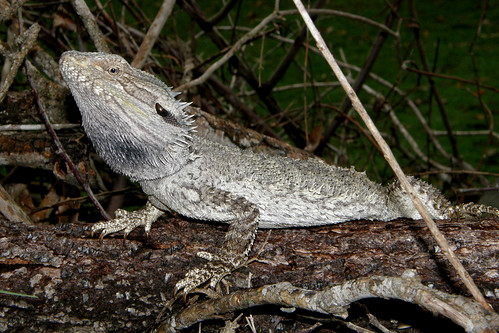The question of how to get rid of mites on a bearded dragon is a common one among reptile keepers. As with any pet, it’s important to keep their environment clean and to provide them with proper care.
Unfortunately, mites can be difficult to eliminate and can quickly spread if left unchecked. Fortunately, with the right knowledge and approach, it is possible to effectively manage and eliminate mites from a bearded dragon’s environment.
In this article, we’ll discuss the best methods for getting rid of mites on bearded dragons.
Here’s How You Can Get Rid Of Mites On Bearded Dragons
Remove Your Beardie From Their Tank
Removing your beardie from their tank is essential in eliminating mite infestations, as it allows you to clean out and disinfect the habitat for a fresh start. Beforehand, be sure to prepare for treatment by researching DIY solutions, such as warm water baths and coconut oil treatments.
After removing your bearded dragon from its tank: clean out every substrate and all decorations; soak wooden items in bleach water; wipe down surfaces with bleach water; vacuum carpets; and treat any fabrics with pet-safe disinfectants.
Once the environment has been cleaned, begin post-treatment care including offering nutritious meals, monitoring bearded dragons closely for signs of mites or other illnesses, bathing them regularly with warm water or Betadine solution baths, and applying olive oil on their bodies.
Finally, consider using Provent-a-Mite spray to get rid of any remaining mites in the habitat. With patience and the right approach, you can eradicate mites from your bearded dragon’s tank!
Make Your Beardie’s Betadine Bath
Bathing your beloved beardie in a Betadine solution is an important step to keeping them safe and healthy, so don’t delay! Using Betadine baths for DIY mite treatments can be effective and non-toxic, so it’s well worth your time.
To make sure you get the most out of the bath, use warm water mixed with half a teaspoon of Betadine per liter. Be sure to thoroughly wash your bearded dragon from head to tail and rinse off any excess solution afterward.
Make sure to keep an eye on them during the bath, as some bearded dragons may react adversely to prolonged contact with the solution. Once you have finished their Betadine bath, return them to their enclosure and monitor them closely for signs of infection or mites.
Proceed to Bathe Your Beardie
Take the necessary steps to keep your beloved beardie safe and healthy by giving them a Betadine bath for DIY mite treatments. Start with a mix of warm water and Betadine solution, which is an effective yet gentle way to reduce the number of mites on your pet’s skin.
Coconut oil can also be used in combination with the Betadine solution, as it can help soothe any irritated areas while providing additional antimicrobial properties. When finished, rinse off the mixture gently from your bearded dragon’s body and pat dry with a clean towel or paper towel.
This will help get rid of any remaining mite eggs that may have been left behind. While both solutions are effective in treating mites on bearded dragons, Betadine is generally considered to be more potent for eliminating pests than coconut oil alone.
Use a Cloth to Apply More Solution
With a damp cloth, gently dab the Betadine solution onto your bearded dragon’s skin to ensure full coverage of any areas infested with mites. This will help ensure that the solution is applied effectively and reaches all of the affected areas.
Be sure to use a soft cloth in order to avoid irritating your beardie’s sensitive skin. The Betadine solution works by killing the mites on contact, so it is important to ensure that you cover every area thoroughly.
To be extra effective, consider using an insecticidal spray in addition to applying the Betadine solution with a cloth. These sprays are often more effective than traditional solutions and can provide long-term protection from mite infestations.
Where Are Mites Found on Bearded Dragons?
Bearded dragons are prone to pesky mite infestations, which can cause serious health issues if left unchecked. Mites can be found on bearded dragons in a variety of places, including the skin, eyes, ears, and mouth.
To identify mites on a bearded dragon, look for tiny black or red spots or dust-like particles along with skin discoloration and discomfort. Prevention is key to avoiding mite infestations – always purchase from reputable sources and quarantine new acquisitions.
Treating mites on other reptiles requires the same steps as treating them on your bearded dragon; however, it is important to remember that mites have evolved over time so not all treatments will work effectively against all strains of mites.
How Do Bearded Dragons Get Mites?
You can’t ignore mites on your bearded dragon – but how did they get there? It’s important to note that prevention methods are the best way to avoid mites on your pet.
Common sources of infestation include purchasing an animal from a pet shop, handling an infested animal, or buying supplies from an infested retailer. To ensure early detection and avoidance of a full-blown mite infestation, it is important to monitor lizards regularly for signs of mites.
Good hygiene measures such as thorough hand-washing after visiting friends with reptiles and avoiding contact with unknown animals can help prevent mite infestations. Finally, never purchase animals from low-quality sources; stick to high-quality sources when acquiring new pets.
What Are the Symptoms of a Mite Infestation?
You may notice tiny arthropods on your pet, anorexia, lethargy, and overall discomfort if your lizard has been infested with mites. These are the symptoms of a mite infestation that you should be aware of in order to treat it quickly.
To identify mites and their symptoms, look for small black or brown spots on your bearded dragon’s body. You may also see them under the scales or near the eyes, ears, and mouth. Additionally, your bearded dragon might exhibit signs of dehydration due to excessive licking or scratching caused by itchiness from mites.
If you suspect your beardie has been infected with mites, there are treatment options available such as coconut oil baths and consulting a veterinarian for medications. Coconut oil is an effective natural remedy for treating mites as it helps soothe inflammation and reduce itching caused by these pests.
However, severe cases should always be treated by a qualified veterinarian who can provide the best advice and treatment plan for your pet’s needs.
How to Prevent a Mite Infestation?
Regular monitoring and quarantine of new bearded dragons are essential to preventing mite infestations. When selecting a bearded dragon, avoid buying from untrustworthy sources.
Never handle reptiles at pet stores or expos as this can introduce mites into your home. Taking these precautionary steps will enable you to maintain a healthy and hygienic environment for your reptile companion.
Regular Monitoring
Monitor your pet regularly to catch mite infestations early and prevent a full-blown outbreak. Regular monitoring is one of the most important preventative measures when it comes to keeping mites away from bearded dragons. Inspecting your pet’s habitat for any signs of mites, such as tiny arthropods or dusty white spots, can help you identify an infestation before it becomes too serious.
Keeping your habitat clean and free of debris also helps keep mites at bay by reducing their food sources. Additionally, regular monitoring allows you to spot other potential health issues that may arise in your bearded dragon which requires immediate attention. Taking these steps will ensure that your bearded dragon stays happy and healthy for years to come.
Quarantine New Beardies
To effectively get rid of mites on your bearded dragon, it is important to take preventive measures. One key step in prevention is the isolation of newly purchased beardies. This means that all new acquisitions should be quarantined and kept separate from other reptiles for at least two weeks before introducing them into the main environment.
Quarantine protocols will help you identify any signs of mites or other parasites quickly and prevent them from spreading to other animals.
It is important to practice hygienic practices when handling new animals such as washing your hands with alcohol-based gel or soap and water after contact with them. Also, only buy bearded dragons from reputable breeders to ensure a healthy pet.
Don’t Buy Beardies From Untrustworthy Sources
It is essential to purchase your bearded dragon from a trusted source to avoid mite infestations and other health issues. To ensure you are getting a healthy pet, take the following steps:
- Avoid shady breeders by researching reputable sources like Hunter Briggs or Reptile Direct.
- Ask for recommendations from experienced owners who have had success with their own beardies.
- Read reviews before making any purchases online or in person.
- Always look for signs of ill health such as lethargy, weight loss, discolored skin, and poor appetite before taking the lizard home.
Purchasing your bearded dragon from an untrustworthy source can lead to major problems down the road and put your beardie at risk of getting mites. Taking the time to research and ask questions can help ensure that your new pet is healthy and happy!
Never Handle Reptiles at Pet Stores or Expos
You should exercise caution when visiting pet stores or attending reptile expos, as handling other animals can potentially transfer mites to your own. To avoid the risk of bringing in mites, quarantine new pets for at least 2 weeks and monitor them closely for signs of infection.
Good hygiene practices are critical–wash hands before and after handling reptiles, keep hands in pockets when visiting pet stores, and be sure to clean cages regularly.
A proactive approach is ideal; if you suspect that an animal might have mites even before purchasing it, contact a veterinarian who can provide advice on how to best deal with the issue. Mite infestations can be difficult to treat so taking preventative measures is key.



